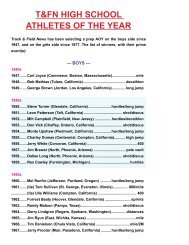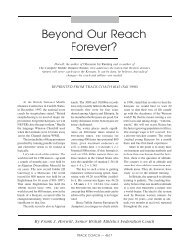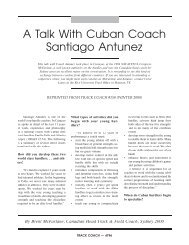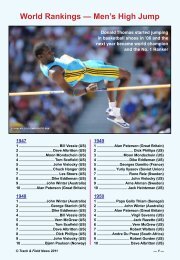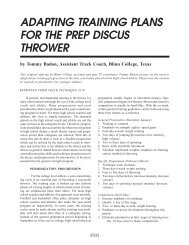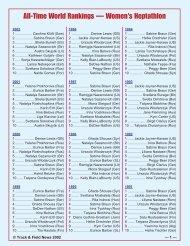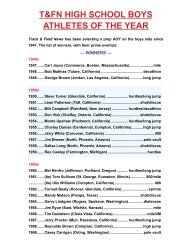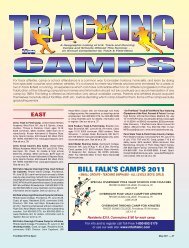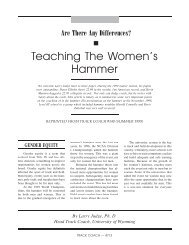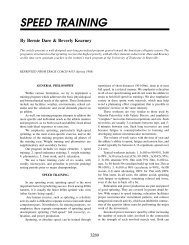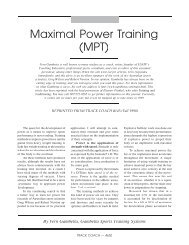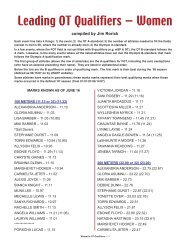Identifying And Developing Elite Hurdlers In The United States
Identifying And Developing Elite Hurdlers In The United States
Identifying And Developing Elite Hurdlers In The United States
Create successful ePaper yourself
Turn your PDF publications into a flip-book with our unique Google optimized e-Paper software.
youth or post-collegiate athletes. It<br />
should be mentioned that most postcollegiate<br />
athletes choose to continue<br />
training with their college coach on<br />
their college campus for many obvious<br />
reasons (success, facilities, familiarity,<br />
etc.), but the predominant reason is the<br />
fact that most often they have nowhere<br />
else to go. <strong>The</strong> USOC has training<br />
centers, but these centers perform more<br />
of a facility/summit function. Our elite<br />
athletes generally will not live at a center<br />
because their coach is somewhere else.<br />
So, in essence, the U.S. has a multitude<br />
of “training centers” across the country<br />
and the collegiate institutions are the<br />
training grounds for our current and<br />
future Olympians.<br />
TALENT<br />
IDENTIFICATION<br />
As a recruiting coordinator for an<br />
NCAA Division I university program,<br />
I have particular criteria which I rely<br />
on to identify talent for my program.<br />
Specifically, for the female hurdler, the<br />
following criteria/information is most<br />
important in talent identification.<br />
1. True performance:<br />
a. hurdles—100H, 300H, 400H<br />
b. open sprints—100m, 200m,<br />
400m or 600m (indoor)<br />
c. technical efficiency/mechanics<br />
d. progression of performances;<br />
2. Anthropometric factors/body<br />
type:<br />
a. height/weight<br />
b. body composition (per cent<br />
fat)<br />
c. lower leg length (soleus)<br />
d. joint mobility (hip);<br />
3. Training age:<br />
a. how many years preparing specifically<br />
for the hurdles<br />
b. first exposure to track and<br />
field;<br />
4. Sports background:<br />
a. other events in track and field—<br />
long jump/triple jump<br />
b. other sports played besides track<br />
and field;<br />
5. Previous injury/illness:<br />
a. stress fractures<br />
b. shin splits;<br />
6. Personality:<br />
a. “heart”/desire/courage<br />
b. compatibility with coach<br />
c. developed goals.<br />
<strong>The</strong>re is a need to highlight a few<br />
items above that have helped me to<br />
recognize the athlete’s potential and<br />
identify critical factors that affect production<br />
of positive hurdling results.<br />
<strong>The</strong> areas that are crucial include:<br />
technical/mechanical efficiency and<br />
horizontal velocity. Speed development<br />
focuses on stride frequency in the 100m<br />
hurdles (since the hurdles are a standard<br />
8.5m apart) and a decrease in groundcontact<br />
time and air time. Both factors<br />
are applicable in the 400m hurdles, with<br />
stride length becoming more important<br />
for stride pattern establishment.<br />
<strong>In</strong> addition, several other elements<br />
are significant to hurdling talent. First,<br />
a gymnastics background is one area<br />
where I feel an athlete develops important<br />
biomotor abilities for track and<br />
field, and specifically hurdling. <strong>The</strong>se<br />
athletes tend to be fearless, more coachable,<br />
more flexible, more disciplined,<br />
have a better kinesthetic feel, have<br />
better overall body strength, and lastly,<br />
they tend to be better competitors. <strong>The</strong><br />
athlete with a gymnastics background<br />
can master good hurdling skills within<br />
3-4 months (Korchemny, 1996).<br />
Second is the determination of<br />
“heart.” I try my best to first create<br />
a window and look into the heart to<br />
determine if that prospective athlete<br />
has the motivation and desire to be the<br />
best athlete he/she can be. This is one<br />
of the most important factors coaches<br />
should identify.<br />
Based on the above criteria, the<br />
coach must use his/her best judgement<br />
for identifying talent for their program.<br />
Note that each institution will be recruiting<br />
for their individual program,<br />
looking for hurdlers who can produce<br />
at the level they are at, with respect to<br />
their athletic conference.<br />
Lastly, one must always remember<br />
that if you recruit thoroughbreds, you<br />
get thoroughbreds. However, this usually<br />
is not the case with most coaches.<br />
Most coaches coach, or rely on, the<br />
developmental type of athlete, so doing<br />
a good job of coaching them is critical<br />
to success in any program!<br />
DEVELOPMENT OF<br />
ELITE HURDLERS:<br />
ASSESSMENT OF THE<br />
INDIVIDUAL ATHLETE<br />
How does this relate to the development<br />
of the individual hurdler? Once<br />
talent is identified, the coach should<br />
determine the individual strengths and<br />
weakness of each athlete.<br />
<strong>The</strong> Profile<br />
When the athlete first enters the<br />
college program, the coach should<br />
build a complete athlete profile. This<br />
should include a complete history, current<br />
status, and goal setting. I utilize a<br />
questionnaire format for the athletes to<br />
fill out). Questions asked are directed at<br />
attaining the most useful information for<br />
the coach to develop his/her individual<br />
training program. It should also take a<br />
holistic approach, looking not only at<br />
physical facts, but also psychological<br />
information, with the concept that mind<br />
and body must work together, train<br />
together, and learn together.<br />
A psychological overview is critical<br />
to the coach in both the planning and<br />
interaction points of view. Questionable<br />
motivations, dysfunctional backgrounds,<br />
coaching changes, negative<br />
behavior, traumatic experiences, etc.,<br />
are key components that can sabotage<br />
even the best teaching approaches.<br />
Testing<br />
Coaches will be able to determine<br />
their athletes’ strengths and weaknesses<br />
through a series of testing parameters.<br />
Testing also serves to identify talent,<br />
motivate athletes, and predict performance.<br />
I use the following tests:<br />
1. Anthropometric factors, e.g., height/<br />
weight/per cent fat/length of soleus;<br />
TRACK COACH — 4506



